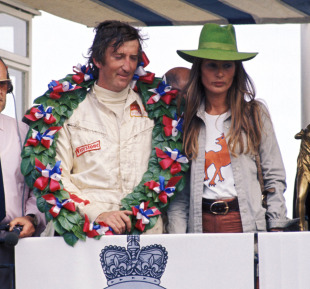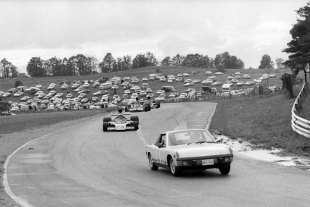
- Drivers:
- Max Chilton
- |
- Jim Clark
- |
- Howden Ganley
- |
- Peter Gethin
- |
- Jochen Rindt
- |
- Wolfgang von Trips
- Teams:
- Brabham
- |
- Iso Marlboro
- |
- Team Lotus
Has the world championship leader ever been killed when in sight of the title? asked Jimmy Brown
The answer to this question, unfortunately, is yes: most obviously in 1970, when Jochen Rindt had what proved to be an unbeatable lead in the world championship when he was killed in the Italian GP at Monza in September. Rindt remains the only posthumous F1 world champion. Monza also claimed the life of the world championship leader in 1961, when the German Wolfgang "Taffy" von Trips was killed in an accident on the second lap. Von Trips probably only needed to finish ahead of his team-mate, the American Phil Hill, to secure the crown with a race to spare: instead a sombre Hill won the race, and collected the title himself. There's a more debatable case for saying the 1968 championship was decided by another fatal accident: Jim Clark had already won the first race of the season before being killed in an F2 race in Germany. Clark's Lotus team-mate Graham Hill went on to take the title, and although Hill has many admirers, most of them would probably admit that Clark was the better out-and-out driver (the previous year, their first in the same team, Clark had scored 41 points to Hill's 15).
Is the new Marussia signing Tom Chilton any relation to the BTCC driver Tom, who I saw pull off a double in the BTCC at Silverstone in 2010? asked Nick Thompson
Yes, they're brothers: Tom Chilton, who's 28 in March, has had a long career in touring cars, first competing in the British championship in 2002. His best seasons were 2005, driving a Honda, and 2010, when he finished fifth overall in a Ford. Overall he had 12 wins in the BTCC, including the two you saw at Silverstone. In 2012 he moved to the World Touring Car Championship with Team Aon, running a Ford Focus, but managed only seven points in a tough season. Max Chilton, who has joined the Marussia F1 team for 2012, is still only 21. He finished fourth in GP2 in 2012, driving a Carlin car supported by Marussia.
What was the most powerful F1 engine? asked Gerry Loader
I'm not sure there's a definitive answer to this one. But it was almost certainly during the era of turbocharged engines, which lasted from 1977 to 1988. BMW produced a turbo for Brabham in qualifying in the early '80s which supposedly could produce 1400 brake horsepower (bhp), but it would have been designed to last little more than a lap (back then you could change engines when you liked). The turbo cars for the race itself generally produced about 1000bhp: today's cars manage something in the region of 700-750.

I remember Howden Ganley being told he'd won a Grand Prix - and then everyone looking pretty stupid when it turned out he hadn't. When was this? asked Mark O'Connell from New Zealand
The New Zealander Howden Ganley had his 15 minutes of fame at the Canadian GP in 1973. The race, at Mosport Park near Toronto, was dogged by rain, and actually was the first world championship race in which a safety car was used, after a collision between Francois Cevert and Jody Scheckter partially blocked the track. There was much confusion about the placings, because cars had been diving in and out of the pits to change tyres as the rain came and went. The safety car was supposed to pick up the leader and, to general surprise, took station just ahead of Ganley, who had started near the back of the grid in his Frank Williams-entered Iso-Marlboro. But Ganley wasn't actually in the lead, and the mistake allowed the drivers who were really in front of him in the race to make up almost a lap on the rest of the field as they joined the "snake" behind the safety car. When the safety car pulled in, Ganley drove well to keep the "chasers" at bay for a while, but then a battle developed between Emerson Fittipaldi and Jackie Oliver, and at the end of the race the Lotus pit celebrated when Fittipaldi crossed the line first. But the chequered flag stayed down, until a group led by Ganley swept by. About three hours later it was agreed that the man in first place had been in the group led by Ganley - but it wasn't him, as he turned out to be a lap behind too. No, the winner was actually Peter Revson, the American in a McLaren, with Fittipaldi second: poor old Ganley ended up sixth. That, mind you, was the one of the best results of his F1 career.
I remember the Brabham "fan car" being banned, but wasn't a Lotus banned too around the same time for some reason? asked Colin Fanning
The Brabham fan car - the BT46B - had a huge fan at the back, which helped aerodynamically - but also, according to other drivers, spewed out dangerous material like stones if you were following it too closely. After Niki Lauda won the 1978 Swedish GP in the fan car, the FIA made it known the car would be banned, and Brabham didn't enter it again. That car was a response to the successful Lotus 78, one of the first to improve road-holding by using tarmac-brushing carbon-fibre "skirts" at the side of the car to improve airflow and almost suck the car onto the track (this was known as "ground effects"). Ten years later the boot was on the other foot, when the Lotus 88 - one of the last cars Colin Chapman had a hand in designing - was deemed illegal. It used an ingenious double-chassis system: the outer one was very stiff, to maximise road-holding, but the inner one was more loosely sprung, for driver comfort. Lotus's drivers, Nigel Mansell and Elio de Angelis, both thought the car was pleasant to drive. But the other teams felt it breached the regulations at the time, which forbade moveable aerodynamic devices, and the FIA agreed. Chapman unsurprisingly thought otherwise, and kept appealing the decision - and kept losing. The Lotus 88 never did race in that form.
Which F1 driver was known as "Peter Rabbit"? asked Mark Douglas
This was the British driver Peter Gethin, who was very successful in other formulae before breaking into F1, in which he had 31 races - and one famous victory, the slip-streaming special that was the 1971 Italian GP. That was the fastest race ever at the time, and remains the one with the closest finish - the first four finishers were separated by only 0.18 of a second. The first man across the line was Gethin in his BRM. I think the "Rabbit" nickname came about because Gethin was small (his father was a successful jockey) and quick, rather than any problems in the dental department. I once heard that Gethin had the best "little black book" (containing girls' phone numbers) on the F1 circuit - a rarity among vintage books, I'd have thought, as its value probably diminished year by year ...
If you want to ask Steven a question, use our feedback form. The most interesting questions will be answered here every other Friday. His long-running Ask Steven column on Cricinfo remains one of that site's most popular features
© ESPN Sports Media Ltd.
 If you want to ask Steven a question, use our feedback form. The most interesting questions will be answered here every other Friday. His long-running Ask Steven column on Cricinfo remains one of that site's most popular features Ask Steven features a number of experts, headed by Steven Lynch, who answer your questions across Formula One as well as a variety of other sports
If you want to ask Steven a question, use our feedback form. The most interesting questions will be answered here every other Friday. His long-running Ask Steven column on Cricinfo remains one of that site's most popular features Ask Steven features a number of experts, headed by Steven Lynch, who answer your questions across Formula One as well as a variety of other sports

